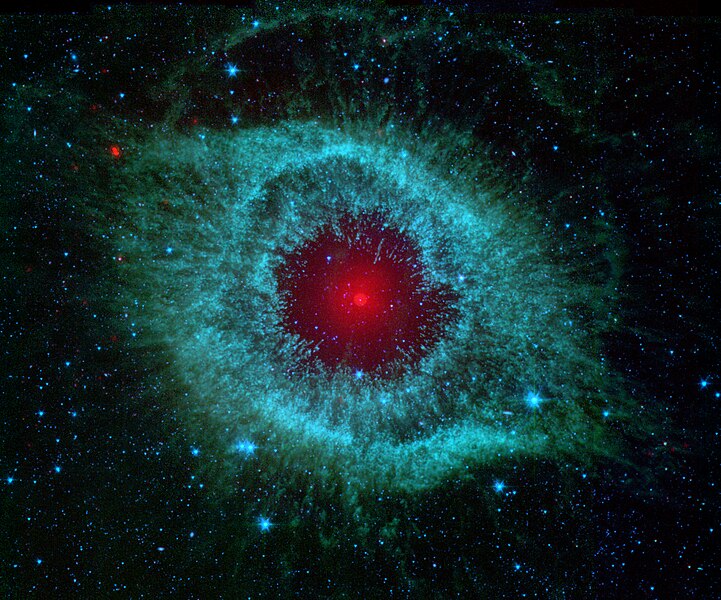فایل:Comets Kick up Dust in Helix Nebula (PIA09178).jpg

سیناق گؤستریشی اؤلچوسو: ۷۲۱ × ۶۰۰ پیکسل. آیری کیفیتلر: ۲۸۹ × ۲۴۰ پیکسل | ۵۷۷ × ۴۸۰ پیکسل | ۹۲۳ × ۷۶۸ پیکسل | ۱٬۲۳۱ × ۱٬۰۲۴ پیکسل | ۲٬۴۶۲ × ۲٬۰۴۸ پیکسل | ۴٬۲۷۹ × ۳٬۵۵۹ پیکسل.
فایلین اصلی (۴٬۲۷۹ × ۳٬۵۵۹ پیکسل, فایل اؤلچوسو: ۷٫۲۲ مگابایت, MIME نوعو: image/jpeg)
فايل گئچمیشی
فايلین اولکی وئرسیياسینی گؤرمک اۆچون گۆن/تاریخ بؤلمهسیندهکی تاریخلری تێقلايین.
| تاریخ/واخت | کیچیک عکس | اؤلچولر | ایشلدن | باخیش | |
|---|---|---|---|---|---|
| ایندیکی | ۱۳ فوریه ۲۰۰۷، ساعت ۰۳:۴۳ |  | ۴٬۲۷۹ در ۳٬۵۵۹ (۷٫۲۲ مگابایت) | Startaq | {{Information |Description=This infrared image from NASA's Spitzer Space Telescope shows the Helix nebula, a cosmic starlet often photographed by amateur astronomers for its vivid colors and eerie resemblance to a giant eye. The nebula, located about 700 |
فايل ایشلدمهسی
بو فایلا هئچ بیر صفحهیه باغلانماییب.
فایلین باشاباش ایشلنیلمهسی
بو فایل آشاغی داکی آیری ویکی لرده ایشلَنیر:
- af.wikipedia.org-ده ایشلنمهسی
- ar.wikipedia.org-ده ایشلنمهسی
- arz.wikipedia.org-ده ایشلنمهسی
- ast.wikipedia.org-ده ایشلنمهسی
- ba.wikipedia.org-ده ایشلنمهسی
- bg.wikipedia.org-ده ایشلنمهسی
- bjn.wikipedia.org-ده ایشلنمهسی
- bn.wikipedia.org-ده ایشلنمهسی
- br.wikipedia.org-ده ایشلنمهسی
- ca.wikipedia.org-ده ایشلنمهسی
- cs.wikipedia.org-ده ایشلنمهسی
- de.wikipedia.org-ده ایشلنمهسی
- dsb.wikipedia.org-ده ایشلنمهسی
- en.wikipedia.org-ده ایشلنمهسی
- Helix Nebula
- Spitzer Space Telescope
- Comet nucleus
- Talk:Helix Nebula
- User:Swirlex/Userboxes
- User:Swirlex/Userboxcode
- NASA
- Wikipedia:Featured pictures/Space/Looking out
- User:Nonexyst
- User:Benjamin112
- Portal:Outer space/Selected picture
- User:Sunfishtommy/sandbox
- Wikipedia:Featured pictures thumbs/44
- Wikipedia:Featured picture candidates/October-2014
- User talk:Benison/Archive 19
- Wikipedia:Featured picture candidates/The God's Eye
- Wikipedia:Picture of the day/October 2016
- Template:POTD/2016-10-12
- Wikipedia:Main Page history/2016 October 12
- User talk:69.50.70.9
- User:The NMI User
- User:Corinne/subpage
- User talk:Benison/Archive 37
- Wikipedia:Userboxes/Science/Astronomy
- User:Catfurball
- User:Huggums537
بو فایلینسراسری ایستفاده لرینه باخین.



